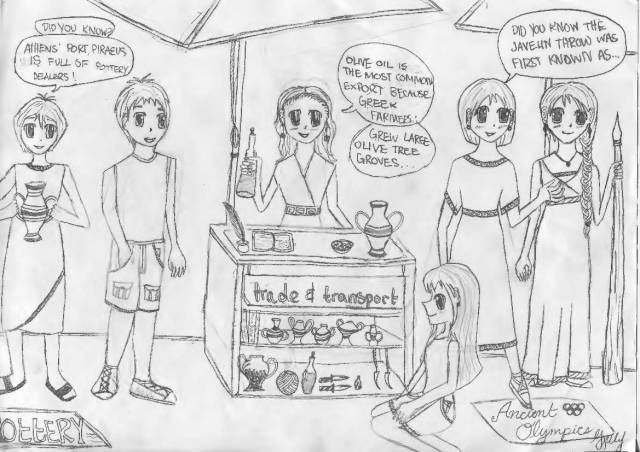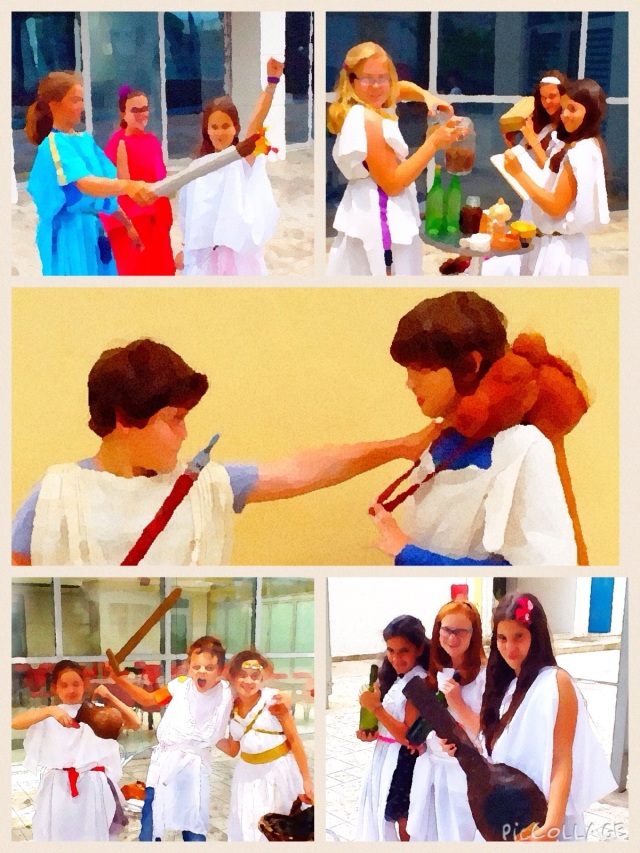
Picture walking into an open space filled with decorated stalls and children clad in ancient costume. Visitors wander from exhibit to exhibit as multiple performances happen in parallel. Presenters perform dramatic scenes as if they were characters from ancient times, sharing moments from their daily lives. As soon as a few visitors gather at a stall the scene begins to unfold. Re-enacting history brings history alive for students and visitors, and is an unforgettable experience!
Creating a living museum is an exciting challenge for both students and teachers alike. While it has all the excitement of a play production, it offers students age-appropriate ownership of script writing and direction. It puts students at the heart of the creative process and shifts the teacher’s role from that of director to facilitator. In a play production, the teacher directs students through long hours of rehearsal yet most students end up in the limelight in the final show for perhaps only five minutes, whereas when students present a living museum every scene is performed simultaneously and repeatedly, and every student is a star!
Student research is the starting point. With the key facts in outline form at their fingertips, students collaborate with other classmates to write an original dramatic scene incorporating as much essential factual material as they can. What makes this presentation different from an oral report, and what brings the information to life, is that it is all told in the present tense and in the first person! Add costumes, props, and audience in an open space with display stalls, and suddenly magic happens! Students travel back in time and become, as ours did today, Ancient Greeks in the Ancient Agora. As a concept this could be easily applied to other social studies units. How about reenacting a Colonial Village, a Rainforest complete with protesting endangered species, or an Explorers’ Convention?
The living museum is a culminating activity, an exhibition of learning from the fifth grade year. The task of writing a scene for a reenactment is complex and needs to be built logically upon skills developed in prior activities. I provided my fifth grade students with two key steps before they attempt this task. First, students need to develop the skills of bringing a story to life by showing the action and interaction between characters and creating dialogue which drives the plot. The Lucy Calkins writing workshop approach guides students to show the details of a story as it happened rather than just tell about it. During writing workshop class, students learn to write such stories based on significant personal experiences. A second step, and more complex task, is to learn to write research-based historical fiction. For example, in a presentation focused on a particular aspect of daily life in Colonial America. Each student writes a soliloquy as a character from Colonial Times (plantation owner, baker, slave, silversmith etc) by writing in the first person, giving an account of the daily life of this individual and developing characterization by sharing the character’s wishes, dreams and fears. In this way the third step, and culminating task of scene writing for the living museum, builds upon all these skills but now creates a context where the student must collaborate with a group to develop something yet more complex, incorporating interaction between characters to convey the key facts in a dramatized narrative. Students work together to brainstorm ideas, assign themselves roles, improvise dialogues and devise the details of their presentation. Some choose to include elements of audience participation! Presenters prepare to answer questions or engage in discussion with the audience while still remaining in their character role at the end of their scene.

The Ancient Agora by Maggie Daly
Each year students devise their own original scene to share their research. Some of the most successful have been: Spartans and Athenians disputing which is the better city state followed by an audience vote; farmers sharing agricultural know-how and food samples; traders bringing wares from far off lands to barter; soldiers recalling their heroic feats in famous battles; Greek gods arguing who is the best; ancient doctors healing patients by sleep therapy; Olympic athletes training the audience in the discus, javelin and long jump events; and a chance to debate with the philosophers.
Assessment on the project is threefold. Students are assessed on their research through their individual outline. They are assessed on their group performance in the event itself, and also on the brochure they each create in technology class. This brochure serves as an invitation to their parents, a visitors guide, a reflection on how the project was created and a teaser to raise anticipation about what the audience will do, see and learn.
With students taking on the writing and development of their own scenes, what is the teacher’s role? One key teacher function is time management. The teacher needs to provide sufficient development time and to determine and manage the project timeline. The following process has been tried and tested. Provide two weeks of social studies and language arts time for classroom-based research, a week for brainstorming, a week for writing dialogue and a week and a half for rehearsal. Early on, perhaps after the first three days of rehearsal, hold a first run-through where students present their unfinished scene to the class and receive peer feedback. This provides stimulus and inspiration to groups who are lagging. Gather props and costumes by the end of the first week of rehearsal to further spur progress. This really helps to bring the whole project to life. Performances suddenly improve! Move rehearsals out into the performance space three to four days before the event so that students can incorporate the potential of available natural features, set and props into their performance.
Finally, the teacher/facilitator needs to coordinate materials and people. This is a great opportunity for cross curricula collaboration. Enlist your technology specialist and/or librarian to assist the students to find resources and take notes for their initial research. In art class help students to each identify and create a key prop for their performance. During technology time create a brochure advertising the attractions on display in the living museum. Parents have a role too! Ask them to lend a sheet for a costume and perhaps some extra props to add realism. Notifying parents by email helps to reinforce communication and ensure that all students have a costume on the big day.
The living museum is a high-value learning activity, not only must knowledge be acquired but then it must be interpreted, owned and harnessed to create something original. The task is not just intellectual but leads also to plenty of social learning as ideas must be communicated, listened to, and evaluated. Much of adult life revolves around collaborative work, and it is essential that we integrate teaching the skills of how to ‘make friends and influence people’ into the unwritten curriculum. Students need coaching in how to give one another constructive feedback and how to deal with conflict to achieve consensus. A collaborative project like this one provides a perfect context and I will be sharing the specifics of how I teach the social skills needed to support such a project in a future blog post.
So, are you ready to relinquish artistic control and allow your students to take the responsibility of being architects of their own learning, and write and devise their own dramatic scenes?
If so, then creating a living museum with your class may be just the project for you!

This project was developed in association with my 5th grade colleagues, Ria Maratou and Marla Coklas, whose inspiration, energy and enthusiasm was invaluable in shaping the final presentation.

I love it Penny! You are awesome, as is this project. The writing and artwork are amazing. I presume that you created the art. Thinking of you and wishing you all the best. Love, Amanda
LikeLike
Thank you, Amanda! This was such a great project to do with the students. They learned so much in so many levels.
I can’t take the credit for the comic, that was made by one of my students, the talented Maggie Daly. Thanks for pointing it out though as I had forgotten to add her name in the caption, so I have fixed that now. The other images are photos “apped” into watercolors!
What exciting projects have you got going with your students? Would you like to be a guest blogger and write a post?
LikeLike
This was such a wonderful, wonderful project to see and experience! The fifth graders really worked hard to deliver a great end product (with yummy treats!). It’s exciting to see a group of students work together to create a wonderful, enriching educational experience. This is also a memory that the fifth graders will take with them forever (I still remember my own fifth grade colonial day well).
Hoping all is well with you and the fifth grade team! -Ms. B
LikeLike
Making learning memorable and the role of food in education ….there must be a blog post in that! So glad that you were able to participate in this great celebration of learning with us last year. Looking forward to reading your news about your new job on your blog. Fifth grade continues to rock on this year!
LikeLike